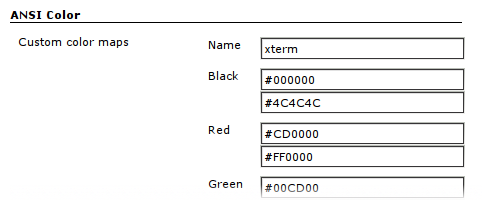This plugin adds support for standard ANSI escape sequences, including color, to Console Output.
This plugin is available here and has a page on the Jenkins Wiki.
java -jar jenkins-cli.jar install-plugin ansicolor
There are 2 ways to explicitly enable ansicolor functionality in a pipeline: as a build wrapper - the cleanest and most preferable one
or as a pipeline step - good for quick checks when you only need part of the output colored.
Can be used to colorize the whole output of a pipeline build. Here is an example rendering a colorful message.
pipeline {
agent any
options {
ansiColor('xterm')
}
stages {
stage('Build') {
steps {
echo '\033[34mHello\033[0m \033[33mcolorful\033[0m \033[35mworld!\033[0m'
}
}
}
}With the following syntax you can use the plugin without allocating a node or a separate build wrapper.
ansiColor('css') {
sh "ls -al"
}
echo 'this will be rendered as-is'
// multiple ansiColor steps within one pipeline are also supported
ansiColor('vga') {
echo '\033[42m\033[97mWhite letters, green background\033[0m'
}The TERM environment variable will be set to the provided name inside the block scope.
ansiColor('xterm') {
echo "TERM=${env.TERM}"
// prints out TERM=xterm
}Traditional, Jenkins UI defined jobs can also take advantage of ansicolor by enabling under "Build Environment" settings.
Example output:
This option is the most suitable when you already have a large amount of jobs and you would like to enable ansicolor functionality for all of them in one go.
In order to use it you need to specify Global color map for all builds on the Global configuration page available under:
Jenkins -> Manage Jenkins -> Configure System
Create a job in Jenkins that executes the following shell script. Don't forget to check the "Color the ANSI Console Output" option.
printf "\e[31mHello World\e[0m\n"
printf "Normal \e[1mBold\e[0m\n"
printf "Normal \e[4mUnderlined\e[0m\n"
Check out this guide for more examples.
If you commonly use Zsh as your login shell, it's important to keep in mind
that the echo command (shell builtin) supports character escaping.
Bash however, does not.
This can cause you a bit of confusion. For example, if you test your
shell scripts (which use echo) in Zsh, and they work fine. Then you
try to run them as part of a job on Jenkins (which will use be using
Bash by default), it's quite possible you won't see colorized output,
instead, you only see the ANSI control codes, still embedded in your
text.
There are ways around this, however, we recommend you use the printf
command instead. It'll just work everywhere, and allow \e, \033
or \x1b to be used as the escape character.
For example:
printf "\e[31mHello\e[0m\n"
printf "\033[31mHello\033[0m\n"
printf "\x1b[31mHello\x1b[0m\n"
Will all print Hello in red on any system / shell that has printf (ie. anything POSIX compliant)
Most of the attributes and color modes described at wikipedia/ANSI escape code were supported, including:
- attributes bold / italic / underline / negative / conceal / crossed-out / framed / overlined
- standard text colors 30-37 and background colors 40-47
- high intensity text colors 90-97 and background colors 100-107 (aixterm)
- xterm 256 colors and ISO-8613-3 24 bit colors (38 and 48)
Not supported attributes:
- faint
- blink
- font switching
- encircled
- ideogram attributes 60-65
The colorize ruby library, for example, emits high intensity codes when using the "light" color options.
RSpec formatters detect whether RSpec is running in a terminal or not, therefore suppressing color output under Jenkins. Specify --colour --tty when calling rspec or add it to your .rspec file.
The ANSI Color Plugin is licensed under the MIT License.
It uses JANSI (Apache 2.0 License).
See CONTRIBUTING.






